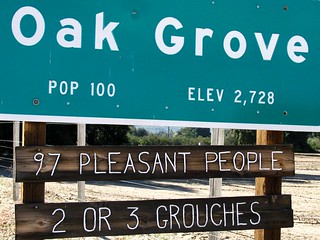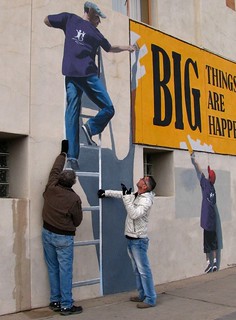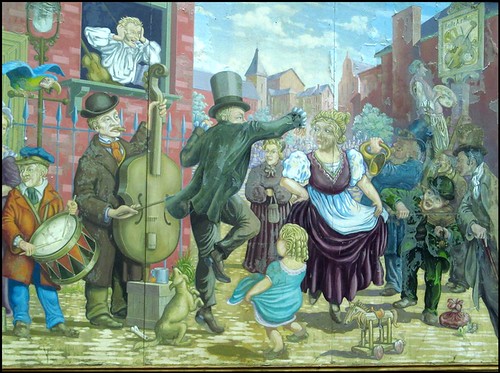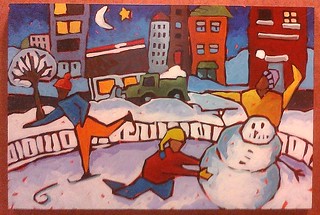 What would it make possible if every community around the world had infrastructure dedicated to ensuring the best possible quality of life for everyone?
What would it make possible if every community around the world had infrastructure dedicated to ensuring the best possible quality of life for everyone?
That question has been on our minds a lot lately, as we have thought about what it will take to accomplish Creating the Future’s mission in the 10 years we have given ourselves.
To understand this in context will require that we step back a bit. So before we begin this exploration, some background.
Mission Accomplished
Creating the Future is a living laboratory, with a 10 year mission: to turn thousands of years of wisdom about possibility and connection into actionable tools and practices that are used commonly in people’s day-to-day lives. The end goal of that mission is the sparking and supporting of a movement to be the world we want to see, right now.
Here’s what we know already:
From our origins as hunter gatherers tens of thousands of years ago, the history of humankind has been a slow, steady march towards our living well individually and collectively.
By studying history, modern psychology and neuroscience, Creating the Future has deconstructed that march towards humanity’s potential, identifying six factors that consistently create conditions for our living well – the “DNA” of social progress enumerated in the six Pollyanna Principles.
By studying modern sociology, Creating the Future has deconstructed the roots of our current cultural norms – the workplace. From the time a child enters school, the workplace is the unifying factor in establishing our collective understanding of what is possible, and our collective beliefs about each other.
 Therefore, if we can infuse that DNA of social progress into the day-to-day habits and practices used in every workplace around the globe (decision-making practices, planning practices, etc.) we will all begin to live well, individually and collectively, right here now.
Therefore, if we can infuse that DNA of social progress into the day-to-day habits and practices used in every workplace around the globe (decision-making practices, planning practices, etc.) we will all begin to live well, individually and collectively, right here now.
What Does This Have to Do with Community Infrastructure?
My very wise friend, Mark Myers, was part of the peer review team when I was writing The Pollyanna Principles. In one of our many conversations about the manuscript, Mark asked me, “What was the most important thing Thomas Edison invented?”
His answer: The electric utility.
“Edison invented all sorts of tools we still use today,” Mark said. “But the most enduring and life-changing was the development of the infrastructure.”
Our communities already have infrastructure for our basic needs – police and fire, roads, water, power, sewer. Beyond those basic needs, we have infrastructure for schools and libraries, for parks, for economic development activities.
Imagine the dramatic results we would see in our communities if there was also infrastructure for the work being done to improve our quality of life!
Here are some of the types of systems that would strengthen the capacity of communities to constantly be striving for extraordinary:
- Convening Systems of all types
- Resource Sharing Systems
- Collaborative Funding Systems
- Mission Support Systems
- Systems for Evaluating What’s Working and Why
 Creating the Infrastructure
Creating the Infrastructure
It has been 5 years since I wrote The Pollyanna Principles and suggested the development of such systems and infrastructure. In that 5 years, we have seen small pockets of services arise – hubs / shared workspaces, new sharing technologies via social media, more educational opportunities. But it is still rare (we haven’t seen any, but that doesn’t mean there are none) to find a community entity whose sole purpose is to convene AND educate AND provide all sorts of systems and services for creating and maintaining an extraordinary quality of life for everyone.
And so Creating the Future is exploring that. We are starting in R&D mode. First, we will explore what types of infrastructure communities HAVE built, what those systems are accomplishing and what is still not being accomplished.
From there, as we consider what part of that work is not being done, we will develop those systems (the D in R&D). And all of that will be a demonstration project, sharing what we learn at every step.
It all starts by asking the question that guides all our work at Creating the Future – the question we invite you to help us explore, right here at this post:
If there were such infrastructure in every community everywhere – an entity dedicated to and holding itself accountable for creating what is possible for that community – what exactly would that make possible?
We have smiled to realize that these would indeed be centers for creating the future. We don’t mean that in the “upper-case” spirit of branding or franchising, but in the “lower-case” spirit of common language – places where the sole purpose would be to reach for what is possible in that community. Unlike narrowly targeted “Centers for Small Business Development” or “Nonprofit Resource Centers,” a center for creating the future would be, as our board members proudly state about our own name, a verb. It would be a cause – a why and a because.
 And so, if there were infrastructure in every community everywhere, dedicated to convening community conversation and convening people who care and want to work together; infrastructure for sharing resources and for collaborative funding of projects and issues; infrastructure for ensuring that people who want to create a better world have the knowledge for doing so and the tools for evaluating what’s working – what might that make possible for YOUR community?
And so, if there were infrastructure in every community everywhere, dedicated to convening community conversation and convening people who care and want to work together; infrastructure for sharing resources and for collaborative funding of projects and issues; infrastructure for ensuring that people who want to create a better world have the knowledge for doing so and the tools for evaluating what’s working – what might that make possible for YOUR community?
We look forward to our thinking this through together. What have you seen work? What have you seen lacking? And what might all that make possible?

Oh boy do I want you to succeed in this mission. Here is a window into what happened when I started thinking about this, First– mm- does infrastructure imply NEW structures? Is that realistic? Do we want to further burden our communities with sustaining new structures? T
hen I thought about what it might take to get folks in existing structures to think and plan and work together on behalf of a shared better future– mm again- seemed like that change process was long and complicated. And then I thought of one of two ideas. The first is a “network weaver” concept and the second is a “concierge” concept.
I am not an expert in either of these but re: Network Weaver-if there were folks who’s purpose was to weave the connections and possibilities among the existing infrastructures in an organization so that they begin to see each other as resources for a collective future– this could be a way forward.
re: Concierge– here I am thinking of people who empower citizens by connecting them to existing resources, organization, etc that help them to take ownership and responsibility for the future they are hoping to create…
This is all vague at this point but I am hoping the wise readers of this community will find some value in playing with these ideas… and I look forward to learning from others…
Pearl:
Thank you for this! I’m not sure it has to be either / or. What might both those approaches make possible, and for whom? If we can get to the heart of what each scenario might accomplish, that will help paint the picture of what success would look like – how a community might be different / better / richer / thriving as a result of whatever approach is chosen.
So… (and not just for Pearl, but for anyone), what might having such infrastructure make possible for a community, and for whom? What might each of the approaches you noted make possible, and for whom? And have you seen anything like this in communities, anywhere?
MAN you’ve got me excited about this – as if I wasn’t excited already!
I second Pearl’s comments – I would love to see communities succeed at this! I think one of the most important aspects of these infrastructures would be to have communities gather around collaboration and intention, with a focus on change rather than on finances or economy. For instance, at the local gatherings that organizers host through the WiserLocal program (http://bit.ly/11LwyvW), there is often an activity called the Marketplace of Giving, much like the collaborative resource sharing systems you mention above. In this practice, community members have a chance to offer non-monetary good and services to one another, and to request needs from the larger group as well. Individual members are then linked up with one another through this exchange, and networking and community bonding inevitably follows. If this is done on a regular basis, it creates an important and very sustainable piece of the infrastructure that could create the kind of thriving communities you write about. Thanks so much for this article, great insights and much to aspire to!
Wonderful project!
I’d highly encourage you to start development as part of your research (they are inseparable), and get things going creating the future you want to see – learning and twisting and turning along the way.
I’d be interested to explore with you how CoCreate fits into this – especially as you learn of comparable initiatives to tap in to! It’s a movement / model / community initiative, of collaborative communities, providing the support infrastructure for people to take action on the things they care about… for us to cocreate our future.
CoCreateADL.com/cocreate
Just saw this and thought of you:
“Resilience comes in two main parts: food production andindustry, supported by two underlying infrastructural elements: smart local information networks and local money systems.”
http://blog.p2pfoundation.net/exploring-resilient-communities-with-john-robb-2-the-infrastructure/2008/09/14
Laura and John and Josef:
I am so interested in the program you noted, Laura. We have decided to take one action – to just get started with something, as John suggests. We are converting our own office into a convening space, aiming to develop a convening program for the hometown community where Creating the Future’s headquarters happens to be – Tucson, Arizona. The link to our very initial thinking is here http://blogs.creatingthefuture.org/whatsnew/2013/08/01/party-time/
Because things are slow now (summer) we are focusing on getting the space ready – it is space that is already in our office, and after 15 years in that office, this will be a great use of an asset we already have.
From there, we will spend slow time exploring all the tremendous info that people are sharing with us, meeting with lots of folks, asking lots of questions, and co-developing whatever program will make sense.
What we’re envisioning at this beginning time (to be further informed by the ideas of others) is that this will not be a one-organization / one-space thing, but tapping on all the spaces in the whole community, to bring people together – networks of information, and people, yes – but there are also networks (if you will) of physical infrastructure that is underutilized in every community. Pulling together all those physical spaces, to create a community web, a physical environment of convening – that excites the hell out of me!
Will read every link you guys are posting, so please keep it all coming. Once we are in full “sleuthing” mode, I am positive everything you guys share will inform not just the answers, but more questions. (The “smart” information networks noted in Josef’s comments!
Thanks, gang – please keep it coming!!!
I’m late to this thread, but thought I would nonetheless share a recent experience that connects to the “mission support systems” you included on your list, Hildy. In a group conversation, we got talking about how often we hear “that’s so-and-so’s mission”, or “we have to be careful we don’t duplicate X”. Our discussion turned to the need for more collaborative approaches – focused on the overlap and intersect between missions, rather than seeing mission as “turf” to be protected (exclusive). When we look around at the many missions that reinforce, support, overlap, or intersect with our own (or could) we are focusing on opportunity and potential – opportunities to partner, potential supporters, co-creation opportunities, etc. Our little group decided we need a LOT more of this mutually supportive (and mutually beneficial) perspective infused in our work. And we have committed to help each other do just that, while encouraging others to “see” individual missions as parts of the collective community landscape. Just talking about mission in a system context took us to wonderful places…it’s exciting to watch all this unfold in Creating The Future’s work, and to be having these inspiring conversations in our own community!
This is so encouraging, Karen – and such a great reframing of the questions we ask and how we see things. So grateful that you shared it!